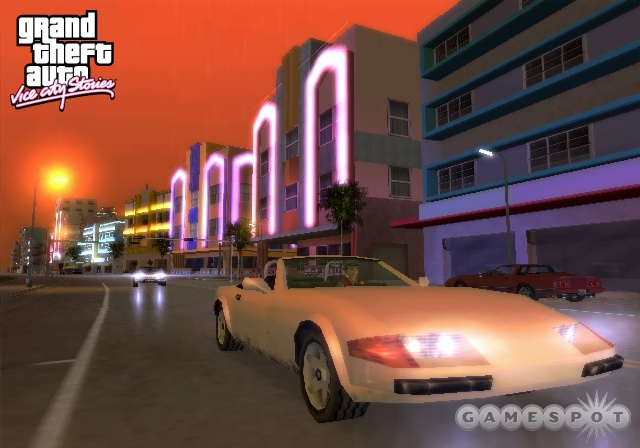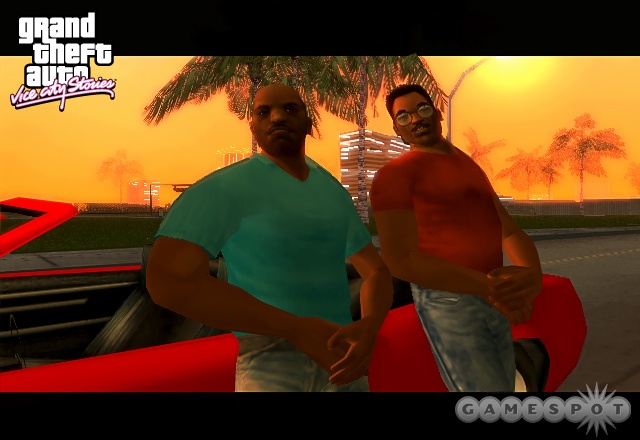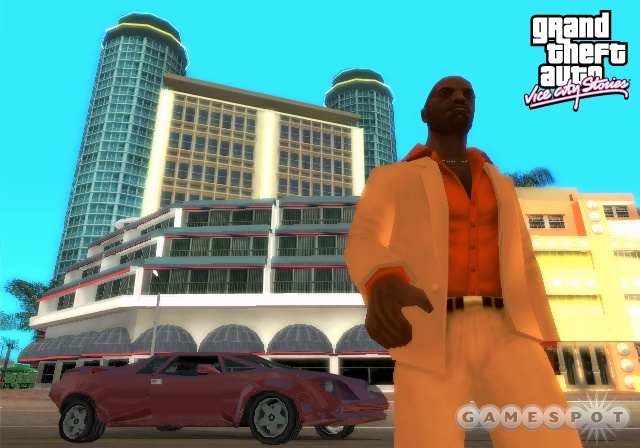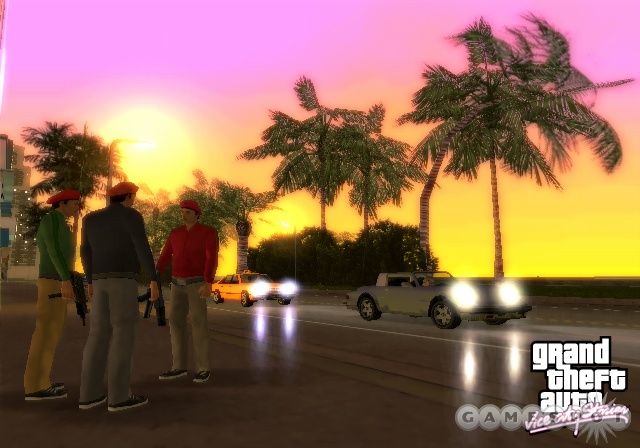We're up to two Grand Theft Auto games on the PSP, and as of now, both have become PlayStation 2 games not terribly long after the handheld version's release. Vice City Stories, the most recently updated of the two, follows a similar side-story formula. Vice City Stories improves upon some of the flaws found in the first game, not the least of which is improved length and direction, as well as a great deal more personality. The story's still pretty subpar, though, and as much as this is very much Grand Theft Auto, certain conventions of the series are starting to feel a bit antiquated. Additionally, much as was the case with Liberty City Stories' transition to the PS2, Vice City Stories loses a lot of its appeal when played on a console versus the PSP. Still, it's only $20, and if you don't own a PSP or just never got around to playing it upon its original release, this isn't a bad way to go if you absolutely, positively must get your GTA fix.

Vice City Stories returns to the pastel- and neon-colored excesses of the 1980s and Vice City. Modeled after '80s-era Miami, GTA: Vice City told a Scarface-inspired tale of Tommy Vercetti, a shunned mobster who found himself sifting through the aftermath of a cocaine deal gone wrong, and subsequently ended up building a major criminal empire throughout the city. It was a bizarre, convoluted, and completely entertaining tale, filled with ridiculous and profane characters, as well as lots of biting satire on the most superficial of decades. Vice City Stories is, again, a prequel, taking place a couple of years prior to the original game. You play as Vic Vance, the brother of central Vice City character Lance Vance. Vic's a strange fellow. When the game begins, he's just joined the army, and he gets off the transport truck at a military base in Vice City. Upon meeting his commanding officer--a borderline psychotic named Jerry Martinez--things start going wrong. We find out that Vic has joined the military to make some money to support his family, specifically his sick brother. But within the first few minutes of the game, you'll find yourself inexplicably picking up drugs for Martinez, killing Mexican gang members, and chauffeuring prostitutes.
Of course, any veteran of this series won't be shocked one bit by missions like these. The trouble here is that the setup for getting Vic into this mess is beyond flimsy. From the get-go, Vic talks about how uncomfortable he is with illegal activities, and yet he does every single illicit thing Martinez asks him to do. If you're someone who doesn't want to do anything illegal, and your boss starts asking you to pick up hookers and hide drugs for him, are you going to just gripe about it and then do it anyway? Not to mention that Vic seems completely willing to run into an apartment complex and start wasting Mexicans without even being ordered specifically to do so. He just says, "I'll go get it" (referring to owed money stashed inside one of the apartments) and goes in guns blazing. GTA heroes are never heroes, exactly, but the trick in the past has been that there's been no attempt to play those characters up as sympathetic. They weren't boy scouts--they were gangsters, killers, and dope dealers. Vice City Stories tries to present Vic as a guy who doesn't want to get into that stuff, yet he freely and frequently does throughout the entire game. He mostly comes off as a hypocritical idiot.
For what it's worth, though, once you get through about the first hour of the game, you'll probably be inclined to stop questioning why Vic is doing what he's doing and just go with it. As time passes, the game settles into the typical progression of GTA missions and oddball characters. While Liberty City Stories was almost devoid of memorable characters, Vice City Stories digs up a few favorites from the original Vice City, and introduces a couple of new ones as well. Vic's mildly crazy brother Lance, the alcoholic gun nut Phil Cassidy, the balls-obsessed Cuban gang leader Umberto Robina, and the foul-mouthed Ricardo Diaz (voiced by Phillip Michael Thomas, Gary Busey, Danny Trejo, and Luis Guzman, respectively) are all back. Lance plays a huge role in the story, but the others aren't quite as prominently featured as they were in the first game. Still, you get a good chunk of time with each of them.
Functionally, Vice City Stories plays very much as Liberty City Stories did on the PS2, return of the right analog stick camera control and all. When running around and shooting people, you simply press the R1 button to lock onto an enemy. Occasionally the game will lock onto random civilians, as opposed to the guy with the submachine gun blowing a hole in your head, but usually it's pretty good about identifying exactly whom you should be killing.
Mostly, though, the combat is quite fun. Running around causing mayhem and blasting away at the masses is just as enjoyable as it's ever been, and there's a good variety of guns and other instruments of destruction to play with. The one part that isn't so good, unfortunately, is the melee combat. Basic fisticuffs and blunt-object beatings are merely a bit clunky, but if you try to get yourself into a fight while holding a gun at close range to someone punching you in the face, you'll lose every time, unless you run a good distance away, turn back, and start firing. For some reason, the game just can't deal with aiming mechanics while you're face-to-face with an enemy; you're basically hosed.

Vice City is a sizable open-world environment and driving around it can be a bit overwhelming at first. Odds are that unless you've had the original Vice City regularly inserted in your PS2 for the last couple of years, you won't remember too much of the city's layout. But even though it'll take a while to figure out all the roads and side streets, there's plenty of familiar scenery and landmarks that appear just about where you remember them. The game's minimap is about as useful as it's ever been in depicting where you are, and there is a larger map to check on in the pause menu. Still, it feels a bit antiquated, especially considering evolutions we've seen in recent games of this type, where the best possible paths for a mission are highlighted on the map. Heck, even an arrow pointer telling you where to turn would be nice.
Driving in the game is pretty much as it's been for years now. The vehicle physics are perhaps a bit more exaggerated than they were in Liberty City Stories, and that's both a blessing and a curse. It's extremely easy to spin out while taking turns in many of the game's cars, trucks, and motorcycles, but at the same time, some of the jumps and ridiculous crashes you can have make those wacked-out physics worthwhile. You will run into weird physics glitches from time to time, and you'll sometimes get stuck in pieces of the scenery. These issues aren't exactly new to the series, but they're as annoying as ever. In addition to cars and bikes, helicopters make their return in Vice City Stories, and they're among some of the most enjoyable vehicles in the game. The flying controls are easy to handle, and flying around the city is often much quicker than trying to drive it.
Liberty City Stories may have had all the usual GTA mission types, but it shortened nearly all of them to the point where it barely felt like you were doing anything of consequence. Vice City Stories corrects this by extending out the majority of its missions a great deal. You'll run into plenty of multitiered missions, with several objectives that appear over time. Yes, you're still killing rival gang members, stealing contraband, chasing down crooks in cars, and the like, but these missions are much more satisfying than anything found in LCS, and it'll take you a decent bit longer to complete the main story than the 10 hours or so that it did in last year's game.

Of course, story missions aren't the only thing to do in Vice City Stories. Along with the usual types of firefighting and vigilante missions, there's a whole empire system to contend with. The premise here is that each of the city's gangs holds a number of businesses around the city. These properties can house any number of illegal activities, ranging from prostitution and loan sharking to smuggling and drug dealing. As it happens, you can take over these businesses by sparking a fight with the gang members inside. Once you do, all you have to do is kill all the nearby gang members, walk inside the business, and smash up the place. After that's done, you can buy the property and install whatever type of illegal venture you please. Doing this earns you a nice chunk of cash each day, and each business you open acts as a save point. Making these business save points seems like Rockstar's way of trying to circumvent the limited save-point issue with the game design, but not being able to just save anywhere is still annoying--even if it's not quite as annoying as it was when this was a handheld game.
The game gives you the option to upgrade each of these businesses over time, both by simply sinking more cash into them, or by doing missions to up each business' reputation. Unfortunately, the missions are woefully uninspired. Each mission tasks you with 15 objectives done consecutively, though in reality, it's more like two. For a prostitution business, for example, you will pick up a hooker, drive her to a client, then pick up another hooker, drive her to another client, go pick up the first hooker, drive her to a new client, go grab the second hooker, chase down the client who ran off without paying, drive that second hooker to a new client, go back and rescue the first hooker from a client trying to beat her up, and so on, and so on, and so on. Calling these missions repetitive would be the understatement of a lifetime. In truth, the amount of cash you get just by leaving businesses at their default reputation is plenty, especially after you take over several of them, so there's no real reason to ever want to bother with the missions.
One aspect that Vice City did better than anything before it (including Grand Theft Auto III) was atmosphere, and Vice City Stories is just about as good in this regard. Everything about the cheeseball decade of the 1980s is on display here. Neon lights, slick sports cars, awful fashion, and fantastic music all permeate the experience. This game nails the same look that Vice City had, and the basic graphics engine looks a good bit better than it did in Liberty City Stories, especially regarding the frame rate, which stays fairly consistent throughout the game. A few technical limitations do tend to still get in the way. The game's lighting is sometimes a bit off-putting, especially around sunset. It just makes everything look rather dark, and sometimes the glare from the sun will totally obscure your ability to see anything on the screen other than bright light. Of course, the biggest issue here is that this is a PSP game that's been blown up to PS2 proportions, and as a result, a lot of the various textures and models look much lower in resolution than what you'd typically find in a PS2 game. It's not an awful-looking game, but it's pretty far from impressive.
The game's audio is easily the high point. Vic, annoying as he is, is voiced well, as are the other characters voiced by celebrities and unfamiliar actors alike. The writing is still sharp, even if the overall storyline isn't. Of course, no GTA game is worth much without great radio stations, and much the way that Vice City set the standard for how music in games ought to be handled, Vice City Stories delivers another fantastic soundtrack. The same selection of radio stations from the original Vice City is on hand here, letting you enjoy the best of '80s rock, pop, dance, and hip-hop, among other genres. There are too many songs to list, but particularly atmospheric highlights include Phil Collins' "In the Air Tonight," Quiet Riot's "Metal Health (Bang Your Head)," and Pat Benatar's "Love Is a Battlefield." Of course, the mix goes much deeper and more eclectic than this, but it'd take forever to list all the fantastic songs included in the game.

The radio DJ chatter was another huge highlight of Vice City, and Vice City Stories brings back all the best DJs and their parodic banter. The best one of all is Fresh FM DJ Luke "Skywalker" Campbell, whom hip-hop aficionados will recognize as the foul-mouthed, sex-crazed mastermind of 2 Live Crew. You'll also hear plenty of bizarre, hysterically funny radio commercials that take plenty of jabs at the cinema, TV, music, fashion, and politics of the '80s. If there's any specific difference between the comedy in Vice City and that found in Vice City Stories, it's that Vice City Stories is a bit meaner, a bit darker in its edge. Vice City certainly had its dark moments, but VCS seems a little more bent on taking angry jabs at aspects of American culture than the first game. This is less a flaw and more a stylistic choice, really.
For those of you who already bought Vice City Stories on the PSP, the PS2 version doesn't offer any additional content (and, in fact, removes content in the form of the PSP game's multiplayer mode), so there's no reason to even consider this release. If you skipped Vice City Stories the first time around, just know that this, much like Liberty City Stories, scratches the same basic itch that the other GTA games do, but not as satisfactorily. The storytelling is some of the weakest of any GTA game, and the game engine isn't nearly as impressive as it once was. Still, for $20, those who just want to experience the gaudy delights of Vice City one more time won't be doing themselves wrong by checking this one out.